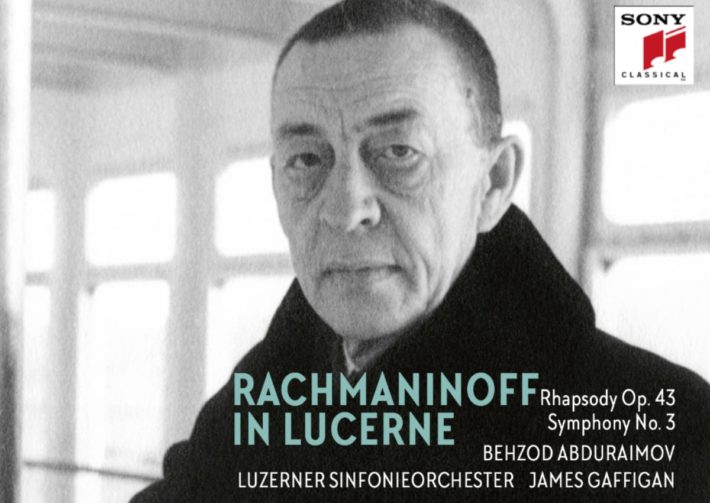This album centers around the location where Rachmaninov composed two of his large-scale works. The composer worked on “Rhapsody on a Theme of Paganini” (1934) and on the Third Symphony (1936-1939) in his “Villa Sena”, located near Lake Lucern. For the Rhapsody, pianist Behzod Abduraimov uses the composer’s own piano from the villa, as Mikhail Pletnev did in few recordings for Deutsche Grammophon.
Rachmaninov composed his Rhapsody on a Theme of Paganini (1934) in just a little over a month. This fine interpretation takes the listener on an adventure through a series of vibrant montages. Each of the 24 variations – written as one continuous work but in the framework of a loose 3-movement structure – has a distinct character, a remarkable feat, given the almost fleeting duration of some variations. The Luzerner Sinfonieorchester under James Gaffigan has a warm, welcoming tone – from a particularly strong woodwind performance emerges a lyrical interpretation of Rachmaninov’s lines. Abduraimov establishes a musical presence that complements perfectly that of the orchestra.
I found the pianist’s sound quality well-conceived, resulting in a solid interpretation that is neither overbearing nor skittish. He creates a vividness in his playing in large part because he does not treat repeated phrases in the same way, regardless of whether they are melodic material or not: a refreshing color change often distinguishes one iteration from another. The orchestra also possesses nuances in its dynamic shading, which enhances a collaborative effort. We are not simply listening to a dialogue between two forces. Instead, we get the chance to hear a multitude of parts and to appreciate the intricacy of Rachmaninov’s writing.
The piece has excellent cohesiveness, but certain variations stand out in terms of their attention to the aforementioned aspects: Variation 5 (track 6) is where Abduraimov creates a “call and response” texture in his chords, creating two dimensions within one phrase. Where the first five variations are rhythmic, percussive, and energetic, Variation 6 (track 7) is the first time we are introduced to the presence of a lyrical character. The nicely contoured crescendos and decrescendos create a sweeping depth; a beautifully performed oboe line concludes the variation with care. The next variation (track 8) marks the appearance of the Dies Irae theme, which continues to be developed later. Thanks to the pianist’s masterful finger-legato and subtle shadings of piano, we hear a uniquely contemplative voice here.
Of course, one must mention the pinnacle of the piece, the iconic Variation 18 (track 19). Abduraimov takes a highly emotive yet sensible approach: his rubatos are effective but not overdone, allowing him to avoid the trap of sounding too sentimental. This variation relies as much on the orchestra as it does the soloist, and the ensemble does not disappoint: the build-up to the high point is dramatic, and we get to savor its luxurious arrival. The last two variations are nothing short of spectacular, with a combination of Abudraimov’s virtuosic power and a sparkling flourish from the orchestra. With a performance as sweeping as this, one soon forgets about the instrument used; while this is a 1930’s Hamburg Steinway D, it’s not vastly different from modern-day concert grands, perhaps conveying a slight edginess and smaller spectrum in the loud passages.
Related Classical Music Reviews
- Review: “Destination Rachmaninov – Arrival” – Piano Concertos No. 1 & 3 – Daniil Trifonov
- Review: Shostakovich – Symphony No. 11 – BBC Philharmonic – Storgårds
- Review: “Italian Inspirations” – Alessio Bax, Piano
The Third Symphony was completed two years after Rhapsody on a Theme of Paganini. More eclectic in its style and musical inspiration, this composition shows Rachmaninov in a more complex tonal and compositional light. Like in the previous work, the Luzerner Sinfonieorchester and Gaffigan portray the many characters present in this symphony: for instance, the meditative opening gives way to a striking display of the full ensemble’s power, completely enveloping the listener. What ties this movement together so well in this performance is its lingering sense of exploration: it seems to meander through moments of insight such as the lovely E major section at 2:14, but also of pensive unrest in its ever-present dissonance of the middle section.
The delightful second movement is performed quite beautifully by the woodwinds and strings, and the third movement is an intriguing change from what has come before. Given the emotional darkness of the previous material, this Finale is somewhat unexpected in its joyful and march-like nature. The orchestra does well in capturing the buoyant spirit but also pays careful attention to the moments that harken back to the musings and emotional lyricism of the other movements.
The sound engineering is well-done on this album. We can hear every little detail down to col legno textures in the Rhapsody or the harp in the Symphony, even amidst dense textures. The clarity is also brought on by the relative “dryness” of the recording: there isn’t a whole lot of reverb which heightens the level of articulation well. The lavish booklet includes black-and-white photos of Rachmaninov and his family members at “Villa Sena”, along with two interesting articles about Lucern’s long association with music and art. With top-notch performances by Abduraimov and the Luzerner Sinfonieorchester, this album belongs on any Rachminov-lover’s shelf.

“Rachmaninov in Lucern”
Rachmaninov – Rhapsody on a Theme of Paganini, Symphony No. 3
Behzod Abduraimov – Piano
Luzerner Sinfonieorchester
James Gaffigan – Conductor
Sony Classical, CD 19075981622
Recommended Comparisons
Read more classical music reviews or visit The Classic Review Amazon store
Follow Us and Comment:
Get our periodic classical music newsletter with our recent reviews, news and beginners guides.
We respect your privacy.









